HEAT GAINS and LOSSES : WINDOWS and SKYLIGHTS (Glass)
The heat gain components through glass consists of solar radiation and conduction. Solar radiation is considered in two parts - direct and diffuse (or scatter). Diffuse radiation is the solar radiation that is absorbed, stored and scattered in the atmosphere. The glass can be in the sun (direct and diffuse radiation) or in the shade (diffuse or scatter radiation). Conduction heat gain occurs due to the difference in temperature on either side of the glass. Conduction heat gain is positive if the outdoor air temperature is greater than indoor air temperature and it is negative (heat loss from the space) if the indoor air temperature is greater. Solar radiation is always positive.
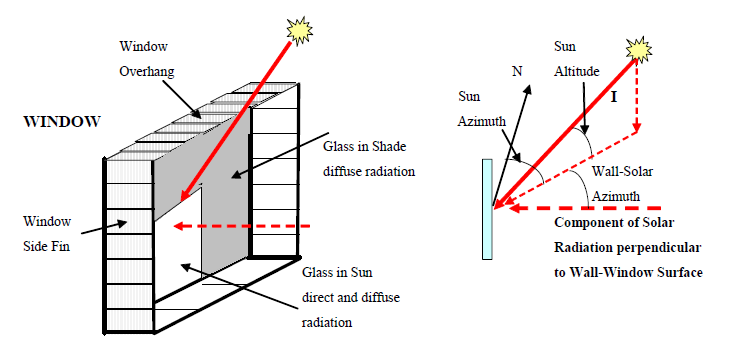
Figure ?
Direct solar radiation is the vector component of the absolute (total) solar radiation that is perpendicular to the glass surface. The Solar Cooling Load (SCL) Factor for a window is based on this value. So for any given hour, the SCL values for windows with different azimuth and tilt angles will have different SCLs although the absolute solar radiation is the same for all windows.
Q-solar = A * SC * SCL
Q-cond = A * U * CLTD
A = Glass Area , SC = Glass Shading Coefficient, U = Glass heat transfer coefficient.
CLTD = Cooling Load Temperature Difference. CLTD for glass depends mainly on the difference between indoor and outdoor temperatures but as with walls and roofs it is affected by the mass and properties of the glass material.
When solar radiation strikes a glass surface, some of it is transmitted, some of it is absorbed and some of it is reflected. The absorbed component increases the temperature of the glass and the heat is slowly conducted (released) to the outside and inside depending on the difference in temperature. Unlike walls that are thick and have high densities, the absorbed portion of the solar radiation is relatively small compared to transmitted and reflected components.
For example, a particular tinted glass has a transmissivity of 0.6 (60% of radiation is transmitted), reflectivity of 0.3 (30% of radiation is reflected) and absorbtivity of 0.1 (10% of radiation is absorbed). The direct solar radiation value is the component of the absolute solar radiation that is perpendicular to the glass surface.
Shading Coefficient (SC) is the ratio of the solar heat through a given glass type under specific conditions to the solar heat gain through a standard reference unshaded glass that was used to determine Solar Cooling Load (SCL) factors. The reference glass is one-eighth thick inch clear double strength single glass and it has an SC = 1 under the specific conditions.
| SC = | Solar heat gain through given glass type |
| Solar heat gain through reference glass type |
Solar Heat Gain Coefficient (SHGC) is the ratio of the measured solar heat through a given glass type to the incident solar heat on the glass. The measured values are affected by the air films on either side of the glass, absorbtivity and by other factors. SHGC is therefore less than SC (about 10% to 15%). SHGC values are used in manual calculations. Input to energy computer programs is usually SC, and the program calculates SHGC based on conditions on either side of the glass. ASHRAE Standard 90.1 specifies SHGC values for different climates because it is based on tested measured values of different glass types and not on theoretical values.
Radiant heat entering through the glass does not directly affect the room space air through which it passes. The radiant heat is first absorbed by the interior surfaces (walls, floor, ceiling) of the space and the contents (furniture and other objects) in the space. The absorbed heat is released to the air in the space through conduction and convection due to the difference in temperature.
Solar Cooling Load (SCL) factors are based on the solar radiation heat gain entering through the glass and the effect of the room surfaces and furnishings in absorbing and transmitting the radiant heat. There is therefore a time lag between the solar radiation entering the space through the glass and when it affects the temperature of the air in the space.
Visible Light Transmission (VLT) factor is the ratio of amount of light (lumens) transmitted through the given glass type to the amount of light transmitted by the standard reference glass type. Visible light and radiation heat are part of the electromagnetic spectrum and vary from each other in wave length. The is therefore a correlation between SC and VLT for different glass types but they are not the same. For building energy efficiency in summer you want to reduce the SC and increase the VLT. This reduces the cooling load due to radiation heat gain and reduces it even further by reducing the heat gains from lighting. Glass manufacturing research and technology tries to develop glass that optimizes the properties of glass for building energy efficiency.
In summary, energy efficient glass depends on it's U-value, SC, SHGC and VLT. Glass manufacturer's data provides this information.
ASHRAE tables for Solar Cooling Load (SCL) factors are therefore based on approximate groups and combinations of different types of room surfaces and furnishings. It is also based on floor levels (ground, middle, top) since this affects the inside surfaces of the space.
ZONE TYPES
The ASHRAE Cooling Load Temperature Difference (CLTD), Solar Cooling Load (SCL) and Cooling Load Factor (CLF) method was developed so that heating and cooling loads can be calculated manually. It consists of building performance tables for different latitudes and different building configurations. The tables were generated using the DOE2 computer program that used more intensive and accurate calculation procedures (example Transfer Function Method for Walls). These tables are published in the ASHRAE 1981 Handbook.
- Room or space zone types were developed for:
- Solar Heat Gain through Glass
- Internal Heat Gains from People, Lights, and Equipment
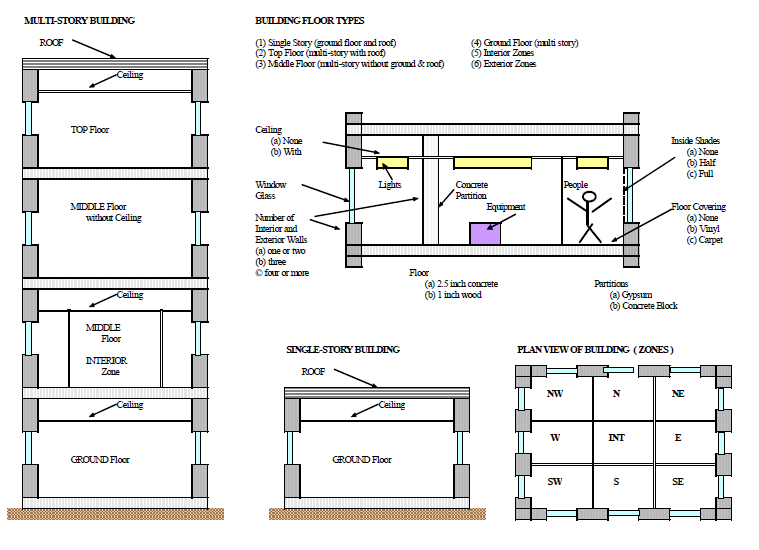
ASHRAE Zones for Solar Cooling Load (SCL) Factors for Glass are based on:
- Floor Level and Room Location
- Single Story Building (Table 8.8-A)
- Top Floor (Table 8.8-B)
- First / Ground Floor (Table 8.8-C)
- Middle Floor (Table 8.8-D)
- Interior Rooms (Table 8.8-E)
- Number of Walls in the Space ( 1 & 2 or 3 & 4 or greater)
- Floor Type ( Concrete or Wood )
- Ceiling Type ( With or Without Suspended Ceiling )
- Floor Covering ( Carpet or Vinyl )
- Partition Type (Gypsum or Concrete Block )
- Inside Shades ( Full, Half or None )
The figure below shows space heat gain time delay.
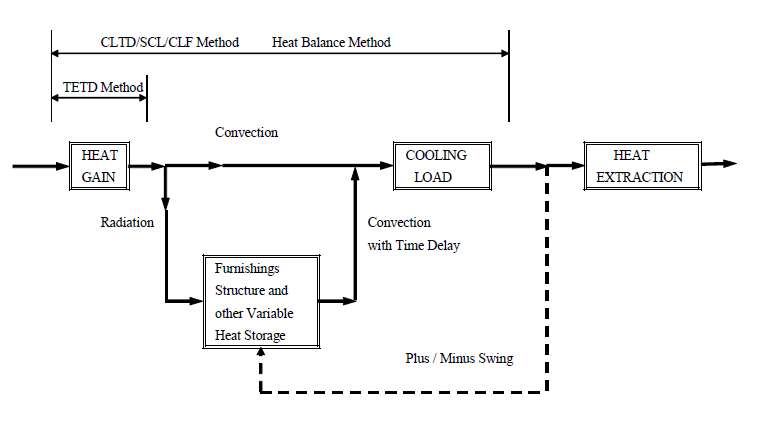
The tables show :
Direct solar radiation intensities for different vertical surface azimuths and for a horizontal surface for 24o North latitude on July 21st and January 21st. Note that solar radiation on the south surface peaks in winter. Heating energy can be reduced by increasing the percent glass on the south.
how the SCL (time delayed) values vary for different vertical surface azimuths and for a horizontal surface for 24o North latitude on July 21st.
EXAMPLES OF ZONE TYPES
for Glass SCL and People, Equipment & Lights CLF

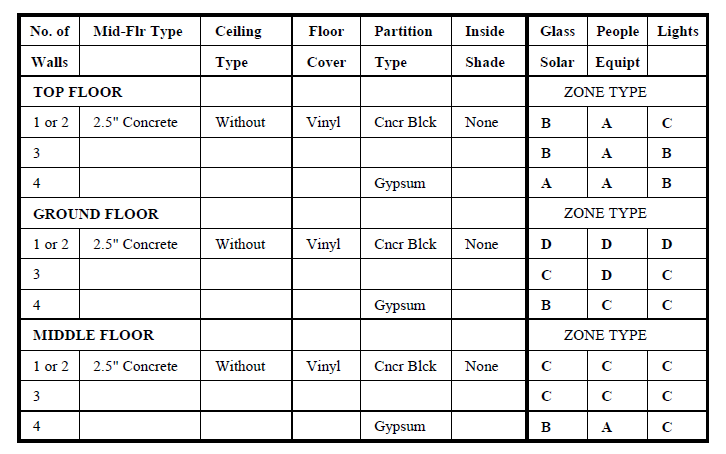
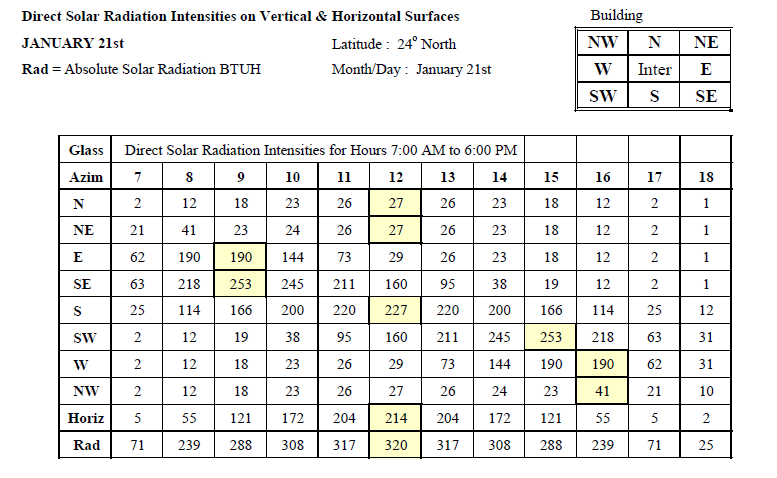
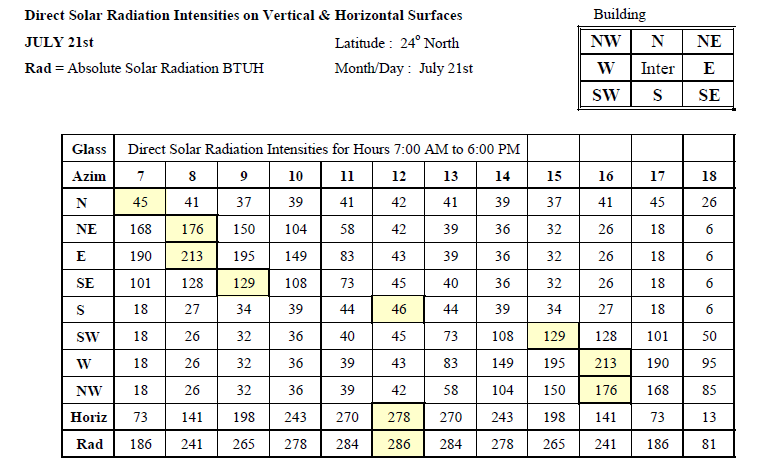
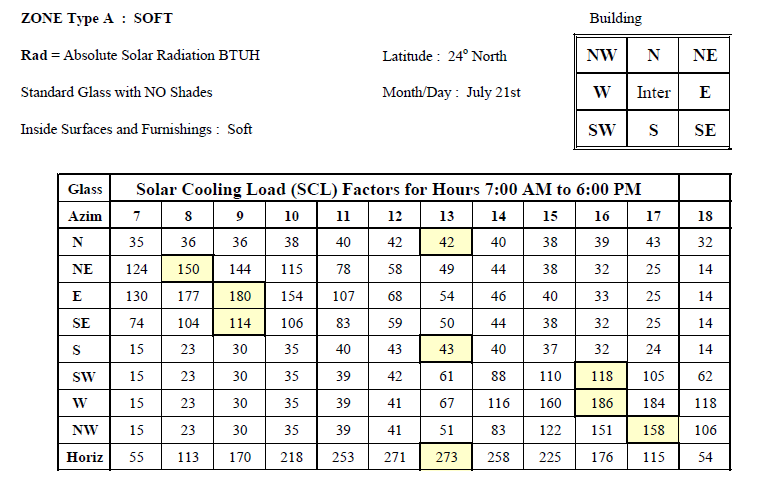

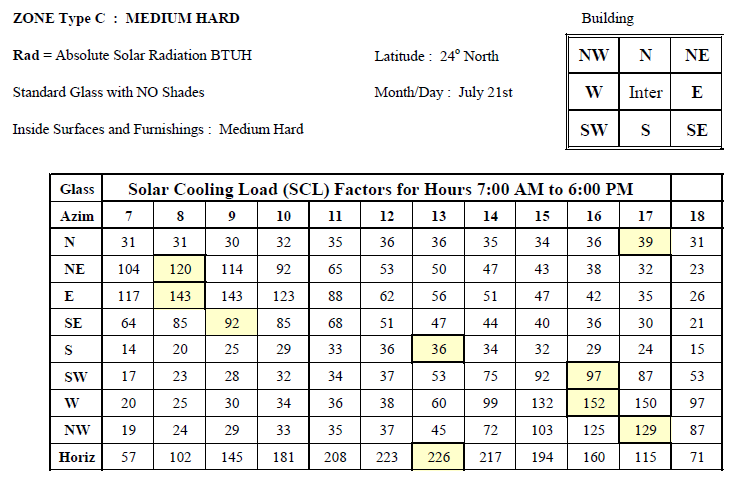
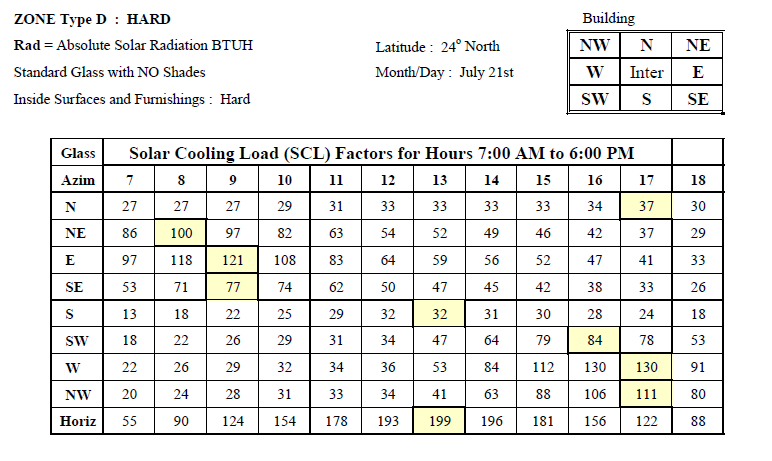
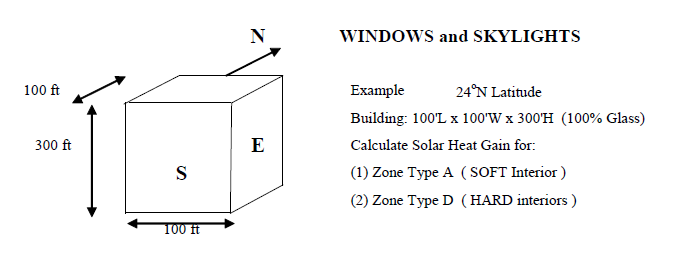
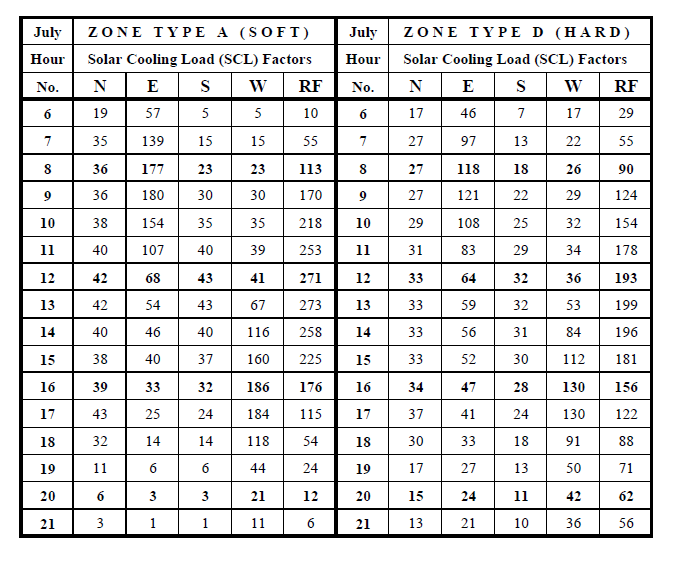

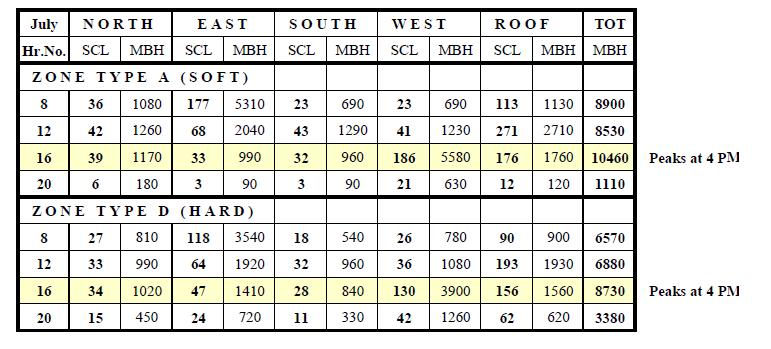

Conduction Heat Gain through Glass (Windows and Skylights)
Q = A * U * CLTD
Q = conducted heat gain through glass
A = glass surface area
U = U-value of glass
CLTD = Cooling Load Temperature Difference for glass

The glass CLTD values in the table above are for based on the following conditions:
| Indoor Room Temperature = | 78oF |
| Outdoor Design High Temperature = | 95oF |
| Average Outdoor 24-Hour Day Temperature = | 85oF |
| Daily Temperature Range = | 21oF |
ASHRAE design weather conditions give T-maximum and T-daily_range.
T-average can be calculated from:
T-average = T-maximum - (T-daily_range) / 2
CLTD values have to be corrected for location conditions other than the values shown above.
CLTD (corrected) = CLTD (table) + ( 78 - T-room ) + (T-average - 85 )
T-room = Actual design temperature of the room
T-average = Actual average summer design temperature of the location.
Example:
Location = Dubai.
Design outdoor temperature = 115oF, Daily range = 20oF , T-average = 115 – 20/2 = 105
Design indoor temperature = 72oF,
CLTD (corrected) for hour 3:00 PM =
CLTD(table) + ( 78 - 72 ) + ( 105 - 85 ) = 14 + 6 + 20 = 40oF


